《无线通信理论》课程教学资源(PPT课件)Fundamentals of Wireless Communication Chapter4 Cellular Systems:Multiple Access and Interference Management
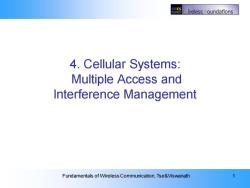
EECS Wireless Foundations 4.Cellular Systems: Multiple Access and Interference Management Fundamentals of Wireless Communication,Tse&Viswanath
4. Cellular Systems: Multiple Access and Interference Management Fundamentals of Wireless Communication, Tse&Viswanath 1 4. Cellular Systems: Multiple Access and Interference Management
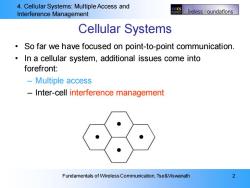
4.Cellular Systems:Multiple Access and EECS Interference Management Vireless oundations Cellular Systems So far we have focused on point-to-point communication. In a cellular system,additional issues come into forefront: Multiple access Inter-cell interference management Fundamentals of Wireless Communication,Tse&Viswanath 2
4. Cellular Systems: Multiple Access and Interference Management Fundamentals of Wireless Communication, Tse&Viswanath 2 Cellular Systems • So far we have focused on point-to-point communication. • In a cellular system, additional issues come into forefront: – Multiple access – Inter-cell interference management
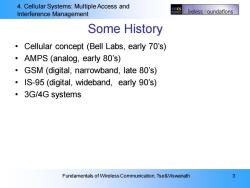
4.Cellular Systems:Multiple Access and EECS Interference Management Wireless F oundations Some History Cellular concept (Bell Labs,early 70's) AMPS (analog,early 80's) GSM(digital,narrowband,late 80's) IS-95(digital,wideband,early 90's) ·3G/4 G systems Fundamentals of Wireless Communication,Tse&Viswanath 3
4. Cellular Systems: Multiple Access and Interference Management Fundamentals of Wireless Communication, Tse&Viswanath 3 Some History • Cellular concept (Bell Labs, early 70’s) • AMPS (analog, early 80’s) • GSM (digital, narrowband, late 80’s) • IS-95 (digital, wideband, early 90’s) • 3G/4G systems
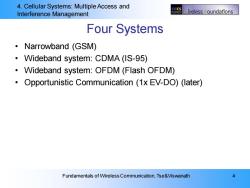
4.Cellular Systems:Multiple Access and Interference Management Wireless oundations Four Systems ·Narrowband(GSM) Wideband system:CDMA(IS-95) Wideband system:OFDM(Flash OFDM) Opportunistic Communication (1x EV-DO)(later) Fundamentals of Wireless Communication,Tse&Viswanath 4
4. Cellular Systems: Multiple Access and Interference Management Fundamentals of Wireless Communication, Tse&Viswanath 4 Four Systems • Narrowband (GSM) • Wideband system: CDMA (IS-95) • Wideband system: OFDM (Flash OFDM) • Opportunistic Communication (1x EV-DO) (later)
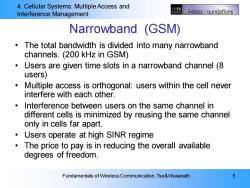
4.Cellular Systems:Multiple Access and Interference Management Wireless F oundations Narrowband (GSM) The total bandwidth is divided into many narrowband channels.(200 kHz in GSM) Users are given time slots in a narrowband channel(8 users) Multiple access is orthogonal:users within the cell never interfere with each other. Interference between users on the same channel in different cells is minimized by reusing the same channel only in cells far apart. 。 Users operate at high SINR regime The price to pay is in reducing the overall available degrees of freedom. Fundamentals of Wireless Communication,Tse&Viswanath 5
4. Cellular Systems: Multiple Access and Interference Management Fundamentals of Wireless Communication, Tse&Viswanath 5 Narrowband (GSM) • The total bandwidth is divided into many narrowband channels. (200 kHz in GSM) • Users are given time slots in a narrowband channel (8 users) • Multiple access is orthogonal: users within the cell never interfere with each other. • Interference between users on the same channel in different cells is minimized by reusing the same channel only in cells far apart. • Users operate at high SINR regime • The price to pay is in reducing the overall available degrees of freedom
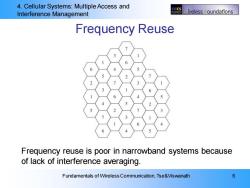
4.Cellular Systems:Multiple Access and Interference Management Vireless oundations Frequency Reuse Frequency reuse is poor in narrowband systems because of lack of interference averaging. Fundamentals of Wireless Communication,Tse&Viswanath 6
4. Cellular Systems: Multiple Access and Interference Management Fundamentals of Wireless Communication, Tse&Viswanath 6 Frequency Reuse Frequency reuse is poor in narrowband systems because of lack of interference averaging
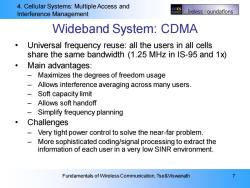
4.Cellular Systems:Multiple Access and EECS Interference Management Wireless F oundations Wideband System:CDMA ● Universal frequency reuse:all the users in all cells share the same bandwidth (1.25 MHz in IS-95 and 1x) ● Main advantages: Maximizes the degrees of freedom usage Allows interference averaging across many users. Soft capacity limit Allows soft handoff Simplify frequency planning 。 Challenges Very tight power control to solve the near-far problem. More sophisticated coding/signal processing to extract the information of each user in a very low SINR environment. Fundamentals of Wireless Communication,Tse&Viswanath 7
4. Cellular Systems: Multiple Access and Interference Management Fundamentals of Wireless Communication, Tse&Viswanath 7 Wideband System: CDMA • Universal frequency reuse: all the users in all cells share the same bandwidth (1.25 MHz in IS-95 and 1x) • Main advantages: – Maximizes the degrees of freedom usage – Allows interference averaging across many users. – Soft capacity limit – Allows soft handoff – Simplify frequency planning • Challenges – Very tight power control to solve the near-far problem. – More sophisticated coding/signal processing to extract the information of each user in a very low SINR environment
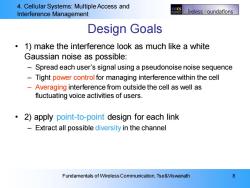
4.Cellular Systems:Multiple Access and EECS Interference Management Vireless oundations Design Goals 1)make the interference look as much like a white Gaussian noise as possible: Spread each user's signal using a pseudonoise noise sequence Tight power control for managing interference within the cell Averaging interference from outside the cell as well as fluctuating voice activities of users. 2)apply point-to-point design for each link Extract all possible diversity in the channel Fundamentals of Wireless Communication,Tse&Viswanath 8
4. Cellular Systems: Multiple Access and Interference Management Fundamentals of Wireless Communication, Tse&Viswanath 8 Design Goals • 1) make the interference look as much like a white Gaussian noise as possible: – Spread each user’s signal using a pseudonoise noise sequence – Tight power control for managing interference within the cell – Averaging interference from outside the cell as well as fluctuating voice activities of users. • 2) apply point-to-point design for each link – Extract all possible diversity in the channel
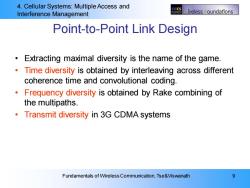
4.Cellular Systems:Multiple Access and ECS Interference Management Wireless F oundations Point-to-Point Link Design Extracting maximal diversity is the name of the game. Time diversity is obtained by interleaving across different coherence time and convolutional coding. Frequency diversity is obtained by Rake combining of the multipaths. Transmit diversity in 3G CDMA systems Fundamentals of Wireless Communication,Tse&Viswanath 9
4. Cellular Systems: Multiple Access and Interference Management Fundamentals of Wireless Communication, Tse&Viswanath 9 Point-to-Point Link Design • Extracting maximal diversity is the name of the game. • Time diversity is obtained by interleaving across different coherence time and convolutional coding. • Frequency diversity is obtained by Rake combining of the multipaths. • Transmit diversity in 3G CDMA systems
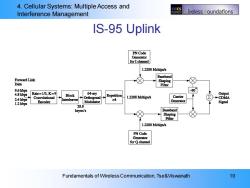
4.Cellular Systems:Multiple Access and ECS Interference Management ireless oundations IS-95 Uplink PN Code Generator for I channel 1.2288 Mchips/s Baseband Forward Link Shaping Data Filter 9.6bp8 -90 4.8 kbps Rate=1/3,K=9 Block 648ry Repetition Output 2.4 kbps Convolutional Orthogonal 1.2288 Mchips/s Carrier CDMA Encoder Interleaver 1.2 kbps Modulator ×4 Generator Signal 28.8 ksym/s Baseband Shaping Filter 1.2288 Mchips/s PN Code Generator for Q chanel Fundamentals of Wireless Communication,Tse&Viswanath 10
4. Cellular Systems: Multiple Access and Interference Management Fundamentals of Wireless Communication, Tse&Viswanath 10 IS-95 Uplink
按次数下载不扣除下载券;
注册用户24小时内重复下载只扣除一次;
顺序:VIP每日次数-->可用次数-->下载券;
- 《无线通信理论》课程教学资源(PPT课件)Fundamentals of Wireless Communication Chapter3 Diversity.ppt
- 西安电子科技大学:《无线通信理论》课程教学资源(教案讲义)Lecture 9 多用户MIMO.pdf
- 西安电子科技大学:《无线通信理论》课程教学资源(教案讲义)Lecture 8 多天线分集复用折中.pdf
- 西安电子科技大学:《无线通信理论》课程教学资源(教案讲义)Lecture 7 MIMO容量与多天线复用技术.pdf
- 西安电子科技大学:《无线通信理论》课程教学资源(教案讲义)Lecture 6 MIMO信道模型.pdf
- 西安电子科技大学:《无线通信理论》课程教学资源(教案讲义)Lecture 5 多用户容量和机会通信.pdf
- 西安电子科技大学:《无线通信理论》课程教学资源(教案讲义)Lecture 4 衰落信道容量.pdf
- 西安电子科技大学:《无线通信理论》课程教学资源(教案讲义)Lecture 3 蜂窝系统与干扰分集.pdf
- 西安电子科技大学:《无线通信理论》课程教学资源(教案讲义)Lecture 2-3 频率分集技术.pdf
- 西安电子科技大学:《无线通信理论》课程教学资源(教案讲义)Lecture 2-2 空间分集技术.pdf
- 西安电子科技大学:《无线通信理论》课程教学资源(教案讲义)Lecture 2-1 时间分集技术.pdf
- 西安电子科技大学:《无线通信理论》课程教学资源(教案讲义)Lecture 1 信道模型(主讲:郑贱平).pdf
- 《无线通信理论》课程教学资源(参考教材)Fundamentals of Wireless Communication(英文版,共八部分).pdf
- 西安电子科技大学:《信号检测与估值》课程教学资源(课件讲稿,2019)第四章 波形信号检测.pdf
- 西安电子科技大学:《信号检测与估值》课程教学资源(课件讲稿,2019)第三章 统计信号估计(主讲:郑贱平).pdf
- 西安电子科技大学:《信号检测与估值》课程教学资源(课件讲稿,2019)第二章 衰落信道上的信号检测.pdf
- 西安电子科技大学:《信号检测与估值》课程教学资源(课件讲稿,2019)第一章 高斯信道上的信号检测.pdf
- 《通信原理》课程教学资源(辅导资料)Selected MIMO Techniques and their Performance.pdf
- 西安电子科技大学:《通信原理》课程教学资源(辅导资料)Viterbi译码.ppt
- 西安电子科技大学:《通信原理》课程教学资源(辅导资料)ISI.ppt
- 《无线通信理论》课程教学资源(PPT课件)Fundamentals of Wireless Communication Chapter5 Capacity of Wireless Channels.ppt
- 西安电子科技大学:《无线通信理论》课程教学资源(PPT课件)Fundamentals of Wireless Communication Chapter6 Opportunistic Communication and Multiuser Diversity.ppt
- 《无线通信理论》课程教学资源(PPT课件)Fundamentals of Wireless Communication Chapter8 MIMO II:Capacity and Multiplexing Architectures.ppt
- 安徽医科大学:《单片机原理与应用》课程教学大纲(生物医学工程专业)Application and principle of single chip microcomputer.pdf
- 西门子PLC培训教程(课件讲稿,共六章).pdf
- 电子电路分析制作与调试(PPT课件讲稿)直流可调稳压电源制作与调试.pdf
- 信阳师范大学(信阳师范学院):电子信息工程专业培养方案(2019版).pdf
- 信阳师范大学(信阳师范学院):电子科学与技术专业培养方案(2019版).pdf
- 信阳师范大学(信阳师范学院):电子信息工程专业课程教学大纲汇编(2015版).doc
- 信阳师范大学(信阳师范学院):电子科学与技术专业课程教学大纲汇编(2015版).doc
- 信阳师范大学:《电工电子》课程教学资源(实验讲义,打印版)《模拟电子线路》实验讲义(共十一个实验).pdf
- 信阳师范大学:《电工电子》课程教学资源(实验讲义,打印版)数字钟电路图.pdf
- 信阳师范大学:《电工电子》课程教学资源(实验讲义,打印版)多功能数字钟电路设计《数字电子技术》课程设计指导.pdf
- 信阳师范大学:《电工电子》课程教学资源(实验讲义,打印版)《电子技术基础实验》设计性实验报告范例.pdf
- 信阳师范大学:《电工电子》课程教学资源(实验讲义,打印版)《数字信号处理》实验指导书.pdf
- 信阳师范大学:《电工电子》课程教学资源(实验讲义,打印版)《PLC原理与应用》实验课程讲义(PLC实验指导讲义S7-200,共十一个实验).pdf
- 信阳师范大学:《电工电子》课程教学资源(实验讲义,打印版)三人表决电路.pdf
- 信阳师范大学:《电工电子》课程教学资源(实验讲义,打印版)《数字电子技术基础实验》讲义——集成单稳态触发的基本应用.pdf
- 信阳师范大学:《电工电子》课程教学资源(实验讲义,打印版)TFG1900A系列函数/任意波形发生器使用指南.pdf
- 信阳师范大学:《电工电子》课程教学资源(实验讲义,打印版)数字存储示波器GDS-1000A-U示波器使用手册.pdf
